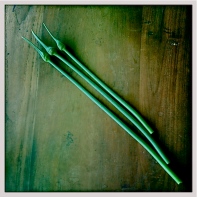This week has been all about seedlings. I grow virtually all our vegetable plants at home and take them to the allotment once they are large enough to sustain the elements and potential pests…. it’s like creating an instant allotment, simply plant in the ground and add water!
April through to June are the busiest months of year to sow seeds and grow vegetable plants and I currently have plenty of seedlings on the go. My potting room and balconies are bursting at the seams so it’s good to finally take some to the allotment.
This week we planted the sweetcorn, courgettes and the Bortlotti beans. In addition we sowed more beetroot and spinach at the allotment.
We never seem to have enough sweetcorn so I decided to think big this year. We have a total of 64 plants, planted in an eight by eight grid; it’s actually more of a cornfield!
This year we are growing a RHS Merit award winner variety called Swift F1. Darrin, our allotment neighbour, grew this variety last year and it looked spectacular. It was fairly vigorous and most of his plants produced two good sized, rich, sweet tasting cobs. The other advantage of this variety is isolation from other varieties isn’t required. Cross pollination of some super sweet varieties can compromise sweetness, flavour and tenderness. What’s not to like?
We also planted 5 courgette plants. A dwarf bush courgette called Verde Di Milano from the Real Seed Catalogue. We grew this variety last year with great success. The plants were healthy and prolific , producing around 20 delicious dark green courgettes on each plant.
And finally we planted the Borlotti beans. This is my third attempt at growing these beans this year. The first lot suffered extreme coastal wind burn and melted. The second lot became etiolated, making it impossible to transport them to the allotment, and finally here are the third batch and they are perfect.
I don’t mind making mistakes, it’s a great way to learn. I’ve discovered that it’s best to place the beans outside as soon as they have germinated. The improved light levels help slow down the rate of growth, preventing etiolation, and obviously they are placed in a very sheltered spot! The only thing I need to be mindful of is slugs and snails. Despite my balcony being around 100 ft above sea level I still get them. When found, they are unceremoniously thrown over the cliff!
At home I have 24 Sutherland Kale plants that are growing well. This is far to many plants for us, but I always work on the basis some will either die or get eaten by snails, slugs or caterpillars! I also have some very young Cavolo Nero and Russian Red Kale. I also have 8 purple sprouting broccoli plants. These will be ready to plant out soon but I need to prepare the brassica bed first. The brassica bed needs a frame and netting especially after last years cabbage white butterfly epidemic.
At the allotment the potatoes continue to grow really well. Flowers are now forming on the second earlies. The first early potatoes should be ready to start harvesting in about 3 weeks time.
And the shallots look fabulous
The strawberries are just beginning to ripen, but there are new pests at large… slugs and snails. Many of the the ripe strawberries have holes, it’s not the birds….. but pesky slugs and snails. The wet weather has its disadvantages.
Last years strawberry crop was magnificent but the weather was hot and dry. Rain provides the perfect environment for slugs and snails to thrive. It seems hard to believe that this tiny slug ate the entire inside of this strawberry!
We garden as organically as we can, and don’t like to use pesticides or slug pellets so we have to accept we are going to encounter pests. Instead I prefer to go on a hunt and found this little lot in and around three strawberry pots. They are fed to the chickens.
And finally, we picked our first bunch of sweetpeas. The scent is heavenly. Summer has arrived!




























Leave a comment